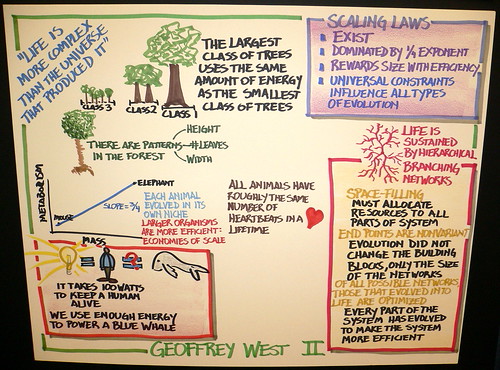Author Archives: Todd Hoff
Author Archives: Todd Hoff
Hey, it's HighScalability time:

Could RAINB (Redundant Array of Independent Neanderthal ‘minibrains’) replace TPUs as the future AI core?
Do you like this sort of Stuff? Please lend me your support on Patreon. It would mean a great deal to me. And if you know anyone looking for a simple book that uses lots of pictures and lots of examples to explain the cloud, then please recommend my new book: Explain the Cloud Like I'm 10. They'll love you even more.

The Westworld season finale made an interesting claim: humans are so simple and predictable they can be encoded by a 10,247-line algorithm. Small enough to fit in the pages of a thin virtual book.
Perhaps my brain was already driven into a meta-fugal state by a torturous, Escher-like, time shifting plot line, but I did observe myself thinking—that could be true. Or is that a thought Ford programmed into my control unit?
To the armies of algorithms perpetually watching over us, the world is a Skinner box. Make the best box, make the most money. And Facebook, Netflix, Amazon, Google, etc. make a lot of money specifically on our predictability.
Even our offline behaviour is predictable. Look at patterns of human mobility. We stay in a groove. We follow regular routines. Our actions are not as spontaneous and unpredictable as we'd surmise.
Predictive policing is a thing. Our self-control is limited. We aren't good with choice. We're predictably irrational. We seldom learn from mistakes. We seldom change.
Not looking good for team human.
It's not hard to see how those annoyingly smug androids—with their perfect bodies and lives lived in a terrarium—could come to Continue reading
Hey, it's HighScalability time:

Rockets. They're big. You won't believe how really really big they are. (Corridor Crew)
Do you like this sort of Stuff? Please lend me your support on Patreon. It would mean a great deal to me. And if you know anyone looking for a simple book that uses lots of pictures and lots of examples to explain the cloud, then please recommend my new book: Explain the Cloud Like I'm 10. They'll love you even more.
Hey, it's HighScalability time:

4th of July may never be the same. China creates stunning non-polluting drone swarm firework displays. Each drone is rated with a game mechanic and gets special privileges based on performance (just kidding). (TicToc)
Do you like this sort of Stuff? Please lend me your support on Patreon. It would mean a great deal to me. And if you know anyone looking for a simple book that uses lots of pictures and lots of examples to explain the cloud, then please recommend my new book: Explain the Cloud Like I'm 10. They'll love you even more.
$40 million: Netflix monthly spend on cloud services; 5%: retention increase can increase profits 25%; 50+%: Facebook's IPv6 traffic from the U.S, for mobile it’s over 75 percent; 1 billion: monthly Facebook, err, Instagram users; 409 million: websites use NGINX; 847 Tbps: global average IP traffic in 2021; 200 million: Netflix subscribers by 2020; $30bn: market for artificial-intelligence chips by 2022;
Quotable Quotes:
@evacide: Just yelled “Encryption of data in transit is not the same as encryption of data at rest!” at Continue reading

This is a guest post by Srushtika Neelakantam, Developer Advovate for Ably Realtime, a realtime data delivery platform.
Ably’s realtime platform is distributed across more than 14 physical data centres and 100s of nodes. In order for us to ensure both load and data are distributed evenly and consistently across all our nodes, we use consistent hashing algorithms.
In this article, we’ll understand what consistent hashing is all about and why it is an essential tool in scalable distributed system architectures. Further, we’ll look at data structures that can be used to implement this algorithm efficiently at scale. At the end, we’ll also have a look at a working example for the same.
Remember the good old naïve Hashing approach that you learnt in college? Using a hash function, we ensured that resources required by computer programs could be stored in memory in an efficient manner, ensuring that in-memory data structures are loaded evenly. We also ensured that this resource storing strategy also made information retrieval more efficient and thus made programs run faster.
The classic hashing approach used a hash function to generate a pseudo-random number, which is then divided by the size of the memory Continue reading
Hey, it's HighScalability time:

Scaling fake ratings. A 5 star 10,000 phone Chinese click farm. (English Russia)
Do you like this sort of Stuff? Please lend me your support on Patreon. It would mean a great deal to me. And if you know anyone looking for a simple book that uses lots of pictures and lots of examples to explain the cloud, then please recommend my new book: Explain the Cloud Like I'm 10. They'll love you even more.
Hey, it's HighScalability time:

Slovenia. A gorgeous place to break your leg. Highly recommended.
Do you like this sort of Stuff? Please lend me your support on Patreon. It would mean a great deal to me. And if you know anyone looking for a simple book that uses lots of pictures and lots of examples to explain the cloud, then please recommend my new book: Explain the Cloud Like I'm 10. They'll love you even more.
Well, not exactly Fishin', but I'll be on a month long vacation starting today. I won't be posting new content, so we'll all have a break. Disappointing, I know. Please use this time for quiet contemplation and other inappropriate activities. Se vidiva kmalu!

If you really need a quick fix there's always all the back catalog of Stuff the Internet Says. Odds are there's a lot you didn't read yet.
Hey, it's HighScalability time:

Did ancient Egyptians invent Wi-Fi? @sherifhanna
Do you like this sort of Stuff? Please lend me your support on Patreon. It would mean a great deal to me. And if you know anyone looking for a simple book that uses lots of pictures and lots of examples to explain the cloud, then please recommend my new book: Explain the Cloud Like I'm 10. They'll love you even more.
Update: Ólafur Arnalds built a robotic music system to accompany him on the piano. He calls his system of two semi generative, self playing pianos—STRATUS. You can hear his most recent song re:member. There's more explanation in The Player Pianos pt. II and a short Facebook live session. His software reacts to his playing in real-time. Then he has to react to the robots because he's not sure what they're going to do. He's improvising like a jazz band would do, but it's with robots. It's his own little orchestra. The result is beautiful. The result is also unexpected. Ólafur makes the fascinating point that usually your own improvisation is limited by your own muscle memory. But with the randomness of the robots you are forced to respond in different ways. He says you get a "pure unrestricted creativity." And it's fun he says with a big smile on his face.
Maybe programming will look something like the above video. Humans and AIs working together to produce software better than either can separately.
The computer as a creative agent, working in tandem with a human partner, to produce software, in a beautiful act of Continue reading

Like the Spanish Inquisition, nobody expects cascading failures. Here's how Google handles them.
This excerpt is a particularly interesting and comprehensive chapter—Chapter 22 - Addressing Cascading Failures—from Google's awesome book on Site Reliability Engineering. Worth reading if it hasn't been on your radar. And it's free!
If at first you don't succeed, back off exponentially."
Why do people always forget that you need to add a little jitter?"
A cascading failure is a failure that grows over time as a result of positive feedback.107 It can occur when a portion of an overall system fails, increasing the probability that other portions of the system fail. For example, a single replica for a service can fail due to overload, increasing load on remaining replicas and increasing their probability of failing, causing a domino effect that takes down all the replicas for a service.
We’ll use the Shakespeare search service discussed in Shakespeare: A Sample Service as an example throughout this chapter. Its production configuration might look something like Figure 22-1.
 Figure 22-1. Example production configuration for the Shakespeare search service
Figure 22-1. Example production configuration for the Shakespeare search service


One of the strategies Jacob Richter describes (How we built a big data platform on AWS for 100 users for under $2 a month) in his relentless drive to lower AWS costs is moving ML from the server to the client.
Moving work to the client is a time honored way of saving on server side costs. Not long ago it might have seemed like moving ML to the browser would be an insane thing to do. What was crazy yesterday often becomes standard practice today, especially when it works, especially when it saves money:
Our post-processing machine learning models are mostly K-means clustering models to identify outliers. As a further step to reduce our costs, we are now running those models on the client side using TensorFlow.js instead of using an autoscaling EC2 container. While this was only a small change using the same code, it resulted in a proportionally massive cost reduction.
To learn more Alexis Perrier has a good article on Tensorflow with Javascript Brings Deep Learning to the Browser:
Tensorflow.js has four layers: The WebGL API for GPU-supported numerical operations, the web browser for user interactions, and two APIs: Continue reading
Hey, it's HighScalability time:

Freeman Dyson dissects Geoffrey West's book on universal scaling laws, Scale. (Image: Steve Jurvetson)
If you like this sort of Stuff then please support me on Patreon. And I'd appreciate if you would recommend my new book—Explain the Cloud Like I'm 10—to anyone who needs to understand the cloud (who doesn't?). I think they'll learn a lot, even if they're already familiar with the basics.

Sanitize and validate configuration inputs, and respond to implausible inputs by both continuing to operate in the previous state and alerting to the receipt of bad input. Bad input often falls into one of these categories:
Validate both syntax and, if possible, semantics. Watch for empty data and partial or truncated data (e.g., alert if the configuration is N% smaller than the previous version).
This may invalidate current data due to timeouts. Alert well before the data is expected to expire.
Fail in a way that preserves function, possibly at the expense of being overly permissive or overly simplistic. We’ve found that it’s generally safer for systems to continue functioning with their previous configuration and await a human’s approval before using the new, perhaps invalid, data.
In 2005, Google’s global DNS load- and latency-balancing system received an empty DNS entry file as a result of file permissions. It accepted this empty file and served NXDOMAIN for Continue reading
Hey, it's HighScalability time:

Bathroom tile? Grandma's needlepoint? Nope. It's a diagram of the dark web. Looks surprisingly like a tumor.
If you like this sort of Stuff then please support me on Patreon. And I'd appreciate if you would recommend my new book—Explain the Cloud Like I'm 10—to anyone who needs to understand the cloud (who doesn't?). I think they'll learn a lot, even if they're already familiar with the basics.

This is a guest post by Alban Perillat-Merceroz, Software Engineer at Teads.tv.

In this article, we describe how we orchestrate Kafka, Dataflow and BigQuery together to ingest and transform a large stream of events. When adding scale and latency constraints, reconciling and reordering them becomes a challenge, here is how we tackle it.

In digital advertising, day-to-day operations generate a lot of events we need to track in order to transparently report campaign’s performances. These events come from:
In the article we focus on tracking events as they are on the most critical path of our business.

Hey, it's HighScalability time:

Programmable biology - engineered cells execute programmable multicellular full-adder logics. (Programmable full-adder computations)
If you like this sort of Stuff then please support me on Patreon. And I'd appreciate if you would recommend my new book—Explain the Cloud Like I'm 10—to anyone who needs to understand the cloud (who doesn't?). I think they'll learn a lot, even if they're already familiar with the basics.